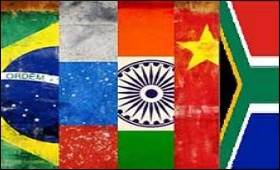|

|
BRICS must now walk the talk
|
|

|
|
| Top Stories |
 |
|
|
|
Bikky Khosla | 18 Oct, 2016
The group of five emerging economies -- Brazil, Russia, India, China and South Africa -- wrapped up its 8th annual summit in Goa last week. These five countries -- which account for 20 percent of global economic output -- together have the potential to alter the order of world trade and the Goa summit -- though held amid the hard reality of slowing growth around the globe and geopolitical tensions in the subcontinent -- reflects their consistent effort to strengthen an emerging market network that can accommodate their own ambitions, not being constrained by the current West-dominated multilateral institutions.
Here are some of the key takeaways from the summit. The Goa Declaration calls for deeper intra-BRICS cooperation in the industrial sector and greater BRICS-BIMSTEC trade and investment. With Indian and Chinese exports to the West declining, this view sounds positive. It also emphasizes on greater cooperation on issues of tax evasion, reiterates the importance of establishing an independent BRICS Rating Agency, and expresses satisfaction over the progress achieved by the New Development Bank. It is also to be noted that an important idea -- BRICS members should trade in their local currencies -- nearly reached fruition in this summit.
As far as the MSME sector is concerned, the BRICS trade ministers, while acknowledging the role of MSMEs in employment generation and export-led growth, agreed on a framework to promote cooperation among MSMEs in crucial areas of trade and investment. In a joint statement following the sixth meeting of BRICS Trade Ministers in New Delhi, it was added that such cooperation could be in the form of information exchange on rules and regulations governing MSMEs; participation of MSME stakeholders in BRICS events; and interface among the major chambers of commerce and industry of the MSMEs. These talks sound good, but I think it is easier said than done.
Over the years, there has been a lot of talk about enhancing trade cooperation among the BRICS economies, but till now not much has been achieved. Politically BRICS has too many contradictions, and economically integration is proceeding at a snail's pace. There is a huge gap between what is happening at the highest political level of BRICS and the ground reality. At present, the block clearly lacks a common regulatory framework. Issues like poor infrastructure and logistics are hampering economic cooperation among these countries. These thing must change if BRICS wants to assume the "global growth engine" status in coming days.
I invite your opinions.
|
|
|
| |
|
|
|
|
|
|
|
Regarding MSME
Rahul Suman | Wed Oct 19 03:51:37 2016
Dear Sir I go through your BRICS opinion on MSME. I am a manufacturer of ceramics and i have small unit in West Bengal. But due to very slow market last from 3 years my factory is closed. There are so many labours dependent on my factory. I need your support so that I can start my factory and develop my local area.

Despite giving huge subsidy to the Industry, Indian Industries fail to offer cheaper products
Pravin | Tue Oct 18 17:58:29 2016
Indian GDP is 2 Trillion USD and China GDP is 10 trillion USD (2014 figures). India gave 110BUSD as subsidy (5.5% of GDP) and China gave 330BUSD (3.3% of its GDP). China captured World market by ensuring cheaper products due to such subsidies with one political party. Whereas in INDIA, despite less interest rate for large corporate cos, easy access to finance, huge tax incentives, our India PV panel and steel manufacturers are unable to supply at low costs becoz, 64 political parties, MP, MLA, MLC, ZP, Municipal elections, Village panchayat elections, IAS system of sucking part of subsidy through Neta Babu nexus, hence, despite high rate of Subsidy vs GDP, INDIA is unable to supply goods at cheaper price and Indian poor are paying more for their local goods despite contributing to the Equity of Large corporate cos and MSME in the form of Capital Subsidy. So, How Indian companies will be competitive to CHINA due to such corruption and more number elections and Neta Babu nexus to fund the elections and many NETA and BABU owning proxy industries with proxy investment in large companies.

|
|
|
|
|
|
|
| |
| Customs Exchange Rates |
| Currency |
Import |
Export |
US Dollar
|
84.35
|
82.60 |
UK Pound
|
106.35
|
102.90 |
Euro
|
92.50
|
89.35 |
| Japanese
Yen |
55.05 |
53.40 |
| As on 12 Oct, 2024 |
|
|
| Daily Poll |
 |
 |
| Do you think Indian businesses will be negatively affected by Trump's America First Policy? |
|
|
|
|
|
| Commented Stories |
 |
|
|
|
|
|
| |
|